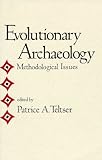Evolutionary archaeology : methodological issues / edited by Patrice A. Teltser.
Material type: TextPublication details: Tucson : University of Arizona Press, c1995. Description: vi, 206 p. : ill., maps ; 25 cmISBN: 0816514615 (cl : acidfree paper); 0816515093 (pb : acidfree paper)Subject(s): Archaeology -- Methodology | EvolutionDDC classification: 930.1 LOC classification: CC75.7 | .E96 1995
TextPublication details: Tucson : University of Arizona Press, c1995. Description: vi, 206 p. : ill., maps ; 25 cmISBN: 0816514615 (cl : acidfree paper); 0816515093 (pb : acidfree paper)Subject(s): Archaeology -- Methodology | EvolutionDDC classification: 930.1 LOC classification: CC75.7 | .E96 1995| Item type | Current library | Call number | Status | Date due | Barcode |
|---|---|---|---|---|---|
 Books
Books
|
The BIAA David H. French Library Shelf 25 - Main Room | A7 TELTS 29623 | Not for loan | BOOKS-000000022524 |
Includes bibliographical references and index.
The methodological challenge of evolutionary theory in archaeology / Patrice A. Teltser -- The structure of selectionist explanations in archaeology / George T. Jones, Robert D. Leonard, and Alysia L. Abbott -- What is it that actually evolves? / Robert C. Dunnell -- Culture history, evolutionary theory, and frequency seriation / Patrice A. Teltser -- A role for "sourcing" in evolutionary archaeology / Hector Neff -- The use of comparative and engineering analyses in the study of prehistoric agriculture / Timothy D. Maxwell -- Evolutionary theory and Native American artifact change in the postcontact period / Ann F. Ramenofsky -- The evolutionary significance of ceremonial architecture in Polynesia / Michael W. Graves and Thegn N. Ladefoged -- The nature and presmise of a selection-based archaeology / Michael J. O'Brien and Thomas D. Holland.
What is the role of neo-Darwinian evolution in explaining variation in prehistoric behavior? Evolutionary Archaeology, a collection of nine papers from a variety of contributors, is the first book-length treatment of the evolutionists' position. Evolutionary archaeologists argue that Darwinian natural selection acts on human behavior, resulting in the persistence of alternative human behaviors and the material products of those behaviors. The contributors all address the methodological requirements of evolutionary theory as it may apply to the nature of archaeological data. Several contributors evaluate the methodological implications of basic evolutionary principles, including the structure of explanations, the units of evolution and analysis, and measurement of information transmission. Others explore the role of specific analytic approaches such as seriation, raw material sourcing, and comparative and engineering analyses. Still others confront the issue of reformulating archaeological problems from the point of view of evolutionary theory.
